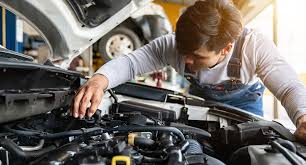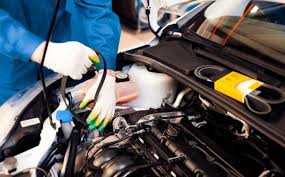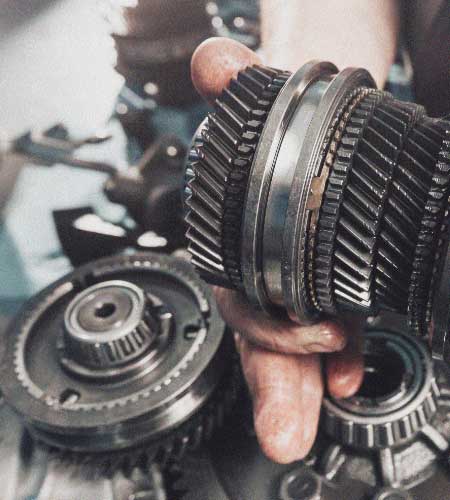Common Types Of Auto Repairs
There are many different auto repair services available to you when your car gets damaged. In fact, there are so many it can all get a bit confusing. It’s important that consumers understand the difference between each service and each professional providing it. Here’s a full breakdown of every kind of auto repair service that you could use and the people providing them.
Auto servicing and service technicians
These are the people who carry out routine servicing on your car or truck. This includes checking oil and fluid levels, electrical wiring and things like your lights and brakes. If there’s a problem with your vehicle, you can trust these guys to pick it up. Because problems can occur with your car, it’s worth taking your vehicle into a service center once a year.
Diagnostic technicians
Diagnostic technicians are a lot like service technicians. They are a little more specialized, however. Rather than fixing problems, they use specialist tools to diagnose underlying problems with your car. Typically, this will cover all of the things that you can’t see with the naked eye like electrical issues, your car’s ignition and the underlying technology that makes the car run. As vehicles are becoming more advanced, the importance of diagnostics is increasing.
Engine, brake and transmission experts
Some auto shops and technicians may specialize in checking and repairing your auto’s key systems like it’s engine, transmission, and brakes. All of these systems are critical to your car’s drivability and safety, meaning you can often pay a premium if you visit a specialist center.
Body repair centers
When your vehicle is involved in an accident, an auto body repair center will have it looking as good as new in an instant. Auto body repair centers are experts at repairing or replacing worn out or damaged body parts, as well as headlights and things like your car’s axels and steering system. If you’re involved in an accident you’ll almost certainly need to turn to an auto body repair center to repair your car’s cosmetic damage. In fact, these centers are the only place you should turn to.
Auto paint experts
Whether you are involved in an accident or just fancy getting a fresh coat of paint applied to your vehicle, auto paint experts are here to ensure your ride looks as fresh as possible. It’s not possible to apply auto paint yourself, so it’s always necessary to visit an expert. Even after an accident where paint has been scraped of your vehicle, these experts can match the color and have your vehicle looking as good as new.

Most common repairs you’ll encounter in an auto repair career
When it comes to car repair problems, there’s a lineup of usual suspects: from spark plugs and brake pads to fuel injectors and more. Whether you would like to work for an independent local automotive business or a national auto body franchise, the right training will prepare you with the skills and knowledge needed to address a full range of auto repairs.
If you are planning to enroll in auto repair courses, or you have already started your program, read on to learn more about five of the most common car repairs you’ll encounter once you break into the industry.
Brake Work: A Pillar of Auto Repair
Once you earn your diploma and become a mechanic you will find yourself frequently (and meticulously) working on car brakes. Professionals in auto careers know that effectively repairing brakes is a vital task—Stats Canada reports a failure to give way or stop causes nearly one quarter of all Canadian car accidents, resulting in hundreds of fatalities and over 2,500 serious injuries per year.
Training will provide you with hands-on knowledge of a car’s entire brake system.
Oil Changes: Routine Tasks for Auto Industry Pros
A good automotive course teaches students about the modern methods that mechanics use to ensure a vehicle’s safety and lengthen its road life. An oil change keeps a car in its best possible running condition. Experienced mechanics know that oil changes are a necessary part of every vehicle’s maintenance. A vehicle’s oil should typically be changed after every few thousand miles.
Over time, dirt and metal filings build up in a car’s oil, making it less effective at lubricating the engine. Regular oil changes lengthen the life of the engine itself. In fact, service records that show frequent oil changes can help the resell value of vehicles, too.
Fixing Automotive Fuel Injector Issues
Faulty fuel injectors are the cause many of today’s visits to the garage. Rough idling, poor fuel economy, misfiring engines and gas leaks can all be traced back to fuel injection system issues—often clogs in the injector itself.
Injectors can become clogged when vehicles are consistently driven at less than ¼ of a tank of gas. Once you become a mechanic, you will be responsible for cleaning clogged injectors with a pressurized solvent, or replacing them altogether. Ensuring that a car’s injectors are functioning properly will prevent potential accidents and untimely break downs.
Replacing Spark Plugs to Meet Auto Industry Standards
Experts in auto industry careers recognize the importance of fixing small parts to avoid big problems. If you’re a detail –oriented person who notices when things aren’t quite right, you’ll thrive in this aspect of the industry.
Spark plugs are responsible for igniting fuel in a car’s cylinders. According to CarMD, many car owners attempt to replace these crucial ignition parts themselves. However, these replacements are often done poorly, reducing gas mileage and melting expensive catalytic converters. Certified mechanics are capable of effectively replacing spark plugs with due care and attention.
By having a mechanic change their spark plugs, drivers will save money in the long run, and they can also be certain that such auto repairs meet industry standards.
Checking Tires: Preventing Blowouts and Accidents
Tire patches or complete replacements are commonplace in most professional body shops. But good training will help you notice the state of a car’s tires even when a client has brought in their vehicle for an unrelated repair. Over-inflation and under-inflation lead to blowouts, causing major accidents on the road.
A good mechanic checks the tires of every vehicle he or she services before letting it hit the pavement. Though car owners are encouraged to check tire pressure regularly, specialized attention from a mechanic’s well-trained eye can detect an issue and save a life.

Most Common Car Problems and Issues
Completing routine service and maintenance is vital to keeping your car, truck, or SUV running strong. At times, however, car issues will arise, and every vehicle will display certain warning signs. To reduce the potential for breakdown, and expensive repairs, we’ve listed the 12 most common car problems that tend to pop up.
1. Warning Lights
A warning or check engine light is the most common issue for US car, truck and SUV owners. These lights illuminate when the vehicle’s ECU (engine control unit) detects an error code triggered by a sensor. Since there are more than 200 possible warning code, having a professional mechanic complete a warning light inspection is the best way to determine the source and make the right repairs.
2. A Sputtering Engine
The engine runs best when air and fuel properly mix and burn in the combustion chamber. To efficiently complete this process, a series of fuel and ignition system components must work together. Though many moving parts help an engine run properly, engine sputtering or misfiring is one of the leading problems. To reduce engine misfiring or sputtering issues, make sure to replace fuel and ignition system components as recommended by your manufacturer.
3. Poor Fuel Economy
When the engine is running efficiently, it burns fuel at a rate that helps improve fuel economy. However, several fuel system parts like fuel filters, air filters, mass air flow sensors, and O2 sensors will eventually get dirty or wear out. If this happens before they are replaced, it will cause the engine to consume more fuel than usual. Again, being proactive about routine servicing provides the solution.
4. Dead Battery
Most car batteries should last about three years or 50,000 miles. A dead battery is usually caused by reduced amps – or electrical currents – which naturally decrease as the battery loses its ability to maintain a charge. A damaged alternator, battery temperature sensor, or other charging system components can expedite this issue. It’s best to replace your car battery every 50,000 miles or three years, even if it’s not showing signs of damage.
5. Flat Tires
While most tires become flat after striking an object or being punctured, it’s possible for simple wear and tear to be the main source. Extend your tire’s lifespan by keeping them properly rotated, as recommended by your vehicle manufacturer. Generally, rotating tires every 5,000 miles (or when you change your engine oil) is the best advice.
6. Brakes Squeaking or Grinding
Like any other moving part on your car, the brake system is intended to wear out over a designated period of time. Brakes are vital for safe stopping, so when they display any symptoms of issues, like squealing, squeaking or a soft brake pedal – it should be inspected by a professional mechanic as soon as possible. While minor problems can cause squeaking or squealing noises, once the brakes start grinding, it’s a definite sign they need to be replaced.

Alternator Failure
The alternator is the part on your vehicle that keeps all electrical systems running once the car starts. It’s also responsible for supplying a charge to your battery to keep it in peak condition. When an alternator breaks, it will eventually cause the battery to wear out prematurely and other starting issues. Check your recommended service intervals and replace the alternator before it breaks to avoid this hassle.
Broken Starter Motor
The starter motor is responsible for cranking your engine over, which begins the starting process. When this component fails, it’s usually because the electrical solenoid has been damaged, the starter motor breaks, or another electrical fault occurs – like a starter relay, for example. While a starter can be replaced before it breaks, it’s difficult to predict when this will happen. It’s best to have a car-starting inspection to determine the problem before assuming it’s the starter.
The different types of auto repair garages
There is no shortage of garages to have one’s car repaired at. This is good news for the customers who have several options. There are three major categories of car auto repair shops.
The Dealership
Dealerships are some of the most common. They are the high end shops of the industry, and have mechanics trained by manufacturers. They offer all in one service, by virtue of the fact that they also sell the vehicles and parts. Many people go to a dealership for warranty repairs or for complex repair operations.
Independent Garage
Independent garages are the majority. They are privately owned, and often come with varying degrees of service delivery and pricing. The most reliable of the independent shops can be compared to the highest level dealerships. However, an advantage they have is that they are cheaper and thus attract more customers. Their location is strategic, making them the convenient option for most motorists. They are unlikely to stock the parts together with providing mechanical repair services. When choosing an independent garage, customers must make sure that the mechanics working on their cars are certified by a professional organization. With certification, customers can be sure of their track record and their skills and knowledge. Car owners embrace them with the knowledge that they will not get low quality repairs.
Specialty Shops
These are auto repair garages that focus on specific cars, or on specific areas of cars. They are preferred for their superior knowledge of a narrow scope of repair jobs. For car owners with luxury or unique exotic cars, this might be the place to go. For those nagging repair jobs that the common repair shop cannot handle, it might be wise to take the car to a specialty shop to get rid of the problem permanently.

